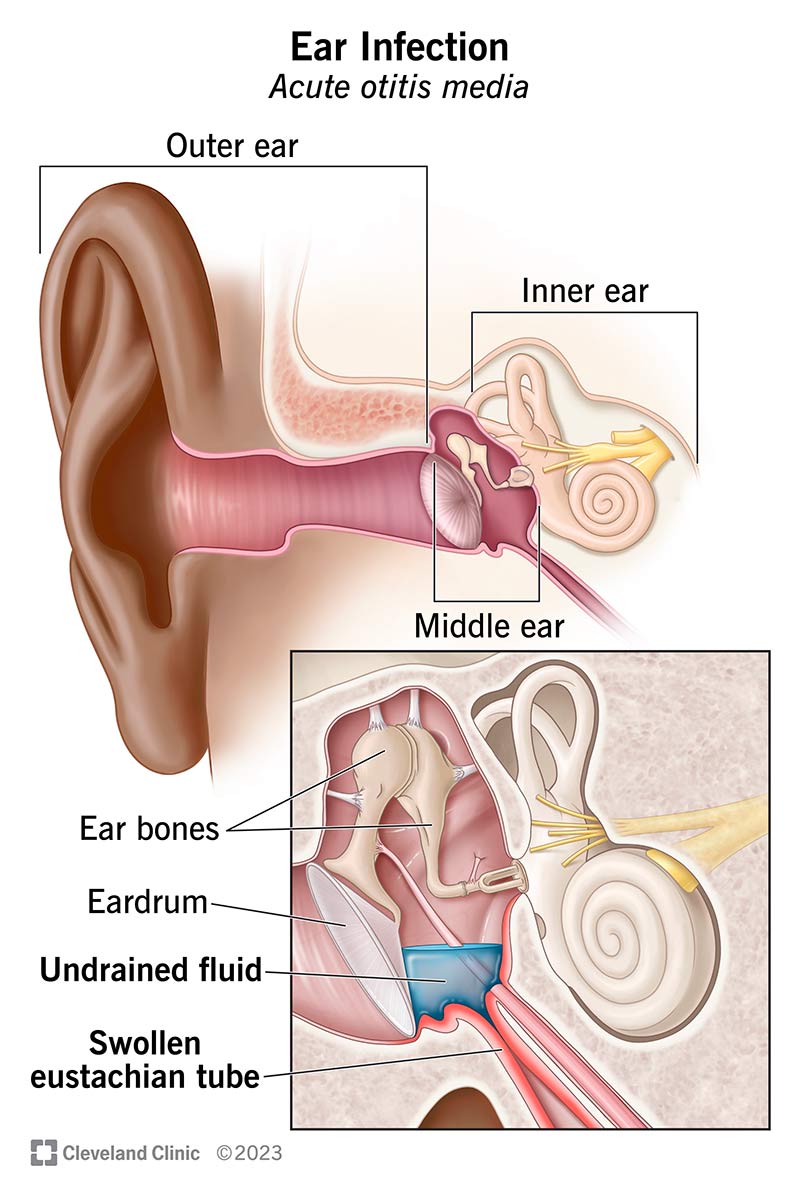Are Ear Infections Contagious
7 min read
1. Ear Infections: The Basics
An ear infection is a bacterial or viral infection that affects the middle ear, the air-filled space behind the eardrum that contains the tiny vibrating bones of the middle ear. Ear infections occur more frequently in children than in adults. This is because children have smaller Eustachian tubes, which connect the back of the nose to the middle ear. The Eustachian tubes are narrower and more horizontal in children than in adults, making it easier for bacteria and viruses to enter the middle ear.
There are two types of ear infections:
• Otitis media with effusion (OME) is fluid in the middle ear without infection.
• Acute otitis media (AOM) is an ear infection with pus in the middle ear.
OME is more common than AOM and is the most frequent reason for children to be seen by a doctor for an ear problem.
AOM is more likely to occur in children under 2 years of age. By age 3, most children will have had at least one episode of AOM.
Children with AOM usually have a fever and are irritable. They may tug or rub their ear. Older children may complain of an earache.
If your child has any of these symptoms, take him or her to the doctor. The doctor will look in your child’s ear with an otoscope, a tool with a light and magnifying lens, to check for signs of infection.
The doctor may also order a hearing test. This is especially important if your child has had multiple episodes of AOM or if OME is causing hearing loss.
If the doctor suspects AOM, he or she will likely prescribe antibiotics. Your child should start to feel better within a few days of starting the antibiotic.
If your child has OME, the doctor may recommend watchful waiting. This means waiting to see if the fluid goes away on its own. OME often goes away without treatment within 2 to 3 months.
In some cases, the doctor may place tubes in your child’s ears. This is a minor surgical procedure that is done under general anesthesia. Tubes allow air
2. Are Ear Infections Contagious?
Most people have had an ear infection at some point in their lives. They are especially common in young children. Ear infections often happen after a cold or flu. That’s because the viruses that cause these illnesses can also cause an ear infection.
Are ear infections contagious?
The simple answer is yes, ear infections are contagious. But there’s a bit more to it than that.
If you have an ear infection, it’s usually because you’ve been exposed to a virus. That means you can pass the virus on to others. But the virus doesn’t necessarily cause an ear infection. In fact, most people who get the virus don’t get an ear infection.
So, while the virus that causes an ear infection is contagious, the ear infection itself is not.
Why are young children more likely to get ear infections?
There are a few reasons why young children are more likely to get ear infections.
First, their immune systems are still developing. This means they’re more likely to get sick in general.
Second, their ear canals are shorter and narrower than adults. This makes it easier for bacteria and viruses to get in and cause an infection.
Third, they’re more likely to be around other children. Children are often the first to get sick when there’s an outbreak of a virus. They can then pass the virus on to others, including adults.
What are the symptoms of an ear infection?
The most common symptom of an ear infection is pain. This can range from a dull ache to a sharp pain. It’s usually worse when you lie down or pull on your ear.
Other symptoms can include:
• Fever
• Drainage from the ear
• Trouble hearing
• Loss of balance
• Nausea or vomiting
• Irritability
How are ear infections treated?
Ear infections usually go away on their own. But if the pain is severe, your child is having trouble sleeping, or there are other concerns, your doctor may prescribe antibiotics.
3. Causes of Ear Infections
There are many different causes of ear infections, but three of the most common are due to bacteria, viruses, and allergies.
Bacteria
One of the most common causes of ear infections is bacteria. Bacteria can enter the ear through the Eustachian tube, which is a small passageway that connects the back of the nose to the middle ear. The Eustachian tube helps to drain fluid and mucus from the middle ear. However, if the Eustachian tube is blocked or not working properly, fluid can build up in the middle ear, providing the perfect environment for bacteria to grow.
Viruses
Another common cause of ear infections is viruses. Viruses are often the cause of upper respiratory infections, such as the common cold, and these infections can lead to ear infections. The virus enters the body through the nose and throat and then travels down the Eustachian tube to the middle ear.
Allergies
Allergies are another common cause of ear infections. Allergies can cause the Eustachian tube to become swollen and blocked, which can prevent fluid from draining properly and can lead to an ear infection. Allergies can also cause mucus to build up in the nose and throat, which can also lead to an ear infection.
4. Symptoms of Ear Infections
There are four main symptoms of ear infections: pain, Otitis media with effusion (OME), hearing loss, and fever.
Ear pain is the most common symptom of an ear infection. The pain is usually caused by inflammation and swelling of the middle ear. This can happen when there is fluid buildup behind the eardrum. The pressure from the fluid can cause the eardrum to bulge and become painful.
OME is another common symptom of ear infections. OME is when there is fluid in the middle ear without any signs of infection. This can cause hearing loss and a feeling of fullness in the ear.
Hearing loss is another symptom of ear infections. This can happen when the inflammation and swelling from the infection cause the eardrum to bulge. This can block sound from getting to the inner ear.
Fever is another symptom of ear infections. This can happen when the infection causes the body to release chemicals that cause inflammation.
5. Treating Ear Infections
Ear infections are one of the most common childhood illnesses. In fact, nearly half of all children will have at least one by the time they’re three years old. And while they’re usually not serious, they can be very painful.
There are two types of ear infections:
1. Outer ear infections (otitis externa)
2. Middle ear infections (otitis media)
Outer ear infections are usually caused by bacteria or fungi. They can occur after swimming or bathing, or from using a dirty towel. Middle ear infections are usually caused by a virus.
Symptoms of an ear infection can include:
1. Ear pain
2. Fever
3. Drainage from the ear
4. Trouble hearing
5. Irritability
If your child has these symptoms, it’s important to see a doctor. Ear infections can sometimes lead to serious complications, so it’s important to get them treated as soon as possible.
There are a few different ways to treat ear infections. The most common is with antibiotics. Antibiotics can help clear up the infection and relieve the pain
If your child is younger than six months old, your doctor may recommend using a topical antibiotic. This is an antibiotic that is applied directly to the ear.
For older children, your doctor may recommend using ear drops. Ear drops are a type of antibiotic that is placed directly into the ear.
In some cases, your doctor may recommend surgery to place tubes in the ears. This can help prevent future ear infections.
Ear infections usually clear up within a week or two. If your child is still having symptoms after two weeks, it’s important to see your doctor again.
While ear infections are usually not serious, they can be very painful. If your child is suffering from an ear infection, it’s important to see a doctor so they can get the treatment they need.
6. Preventing Ear Infections
Ear infections are one of the most common childhood illnesses. They are also one of the most preventable. Here are six tips for preventing ear infections:
1. Keep your child’s ears clean. Wax buildup can trap bacteria and increase the risk of infection. Use a warm, damp cloth to clean the outer ear.
2. Avoid putting foreign objects in your child’s ear. This includes fingers, cotton swabs, and earbuds.
3. Avoid exposure to secondhand smoke.
4. Use a humidifier in your child’s bedroom to keep the air moist.
5. Feed your child a healthy diet. A diet rich in vitamins A, C, and D can help boost the immune system and reduce the risk of infection.
6. Get your child vaccinated. The flu vaccine can help reduce the risk of ear infections. The pneumococcal vaccine can also help protect against the bacteria that cause ear infections.







